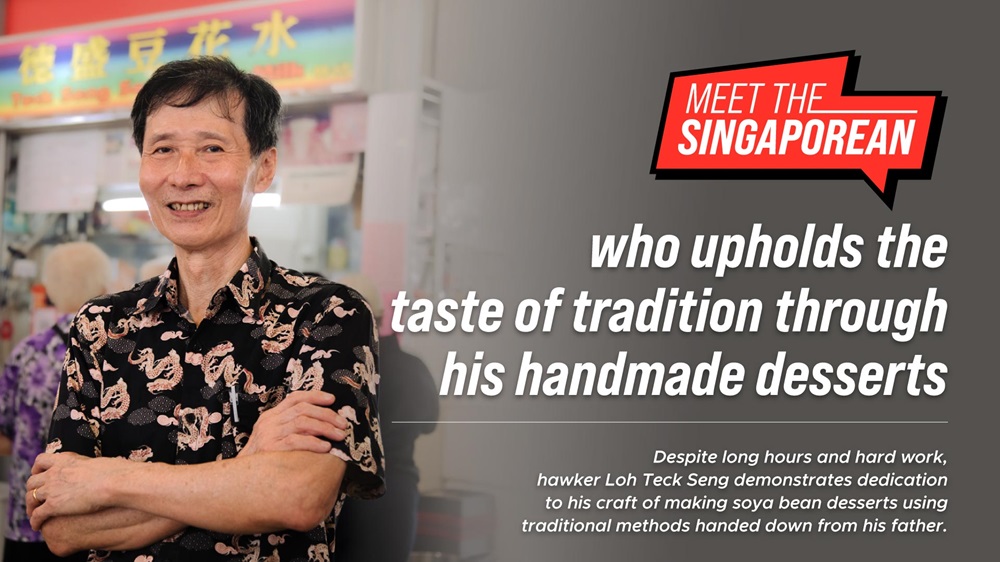Meet the Singaporean - Loh Teck Seng
8 February 2023

Mr Loh, a second-generation hawker, took over his father’s business in the 1980s. He tells us more about the early days, what’s kept him going, and his musings about the future of Singapore’s hawker culture.
It’s 11pm and Tiong Bahru Market & Food Centre is a shadow of its busy, bustling daytime self. At a time when the rest of the food centre is closed, a lone figure is seen swiftly moving around a brightly-lit stall. Here, we have second generation hawker, Mr Loh Teck Seng, who is just starting his night, busy preparing for the next day’s business.
Making soya bean milk the traditional way

(Mr Loh grinding the soya beans. / Photo by Type A)
Mr Loh makes soya bean milk and beancurd the traditional way: by hand, with minimal work done by machines. There is much to be done before the sun rises: grinding soybeans that were soaked for at least four hours; stirring the grounded beans and cooking them over a fire in a traditional wok; and straining the cooked mixture through a muslin cloth. This process is repeated at least six times before he makes enough to sell for the day – the equivalent of 400 to 500 cups of soya bean milk.

(The ground soya beans are cooked in a traditional wok. / Photo by Type A)

(Mr Loh straining the cooked mixture through a muslin cloth. / Photo by Type A)
It is a laborious process but it is one that Mr Loh has stayed true to for close to 40 years. This was passed down to him from his own father, who started selling soya bean milk and beancurd in the 1950s.

(Photo by Type A)
From as young as seven years old, Mr Loh would join his father as he plied his wares from a hawker pushcart at a market in Tiong Bahru. “He would push it there from Tanglin Road or River Valley, which took about 30 minutes,” he recalls, adding that he would help push the cart along as well.
Back then, helping his father sell soya bean milk and beancurd was the last thing on his mind. “I was not really there to work; it was more to have fun,” quips Mr Loh. He started helping his father out more as he grew older, spending weekends and school holidays working alongside him. Mr Loh continued doing so after completing his national service, and even after he secured his own job. By then, his father had moved into a permanent stall at the then-Lim Liak Street Hawker Centre.
Getting retrenched during the recession in 1985 was what led Mr Loh to take over his father’s business that same year. Being present at his father’s stall from a young age meant that customers were already familiar with him. This was what made his transition and business succession a smooth one. 38 years on, he runs the stall with his wife and daughter, who help to serve customers. Making his soya bean milk and beancurd continues to be a solo endeavour, which he does six days (and nights) a week without fail.
Mr Loh has even made improvements to his father’s recipe over the years. “The beancurd I make is now tastier and smoother than my father’s,” he says with a hint of pride, quoting the Chinese idiom 青出于蓝而胜于蓝 (the student surpasses the teacher).
Connecting with customers
A steady stream of customers keeps Mr Loh and his family busy on an average morning, with a snaking queue often seen in front of the stall. There’s no online marketing involved; he relies completely on word of mouth, along with the occasional online review or feature.

(Photo by Type A)
Keeping the tradition alive
For any tradition to be kept alive, it has to be passed down to the next generation, and the next. Mr Loh has imparted his traditional method of preparing soya bean milk and beancurd to his son, who’s currently in his early thirties and is holding down his own job. “Even though he has learnt this skill, I’ll leave it to him to decide whether he wants to take over my business,” he says.
– Loh Teck Seng, 68, second-generation hawker and owner of Teck Seng Soya Bean Milk
